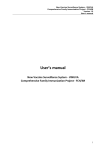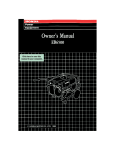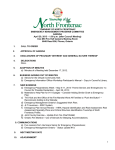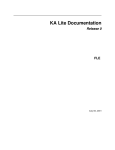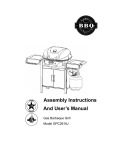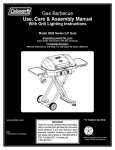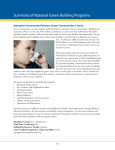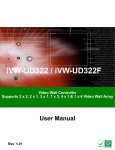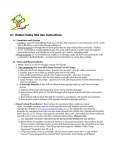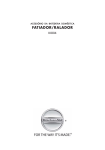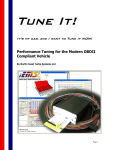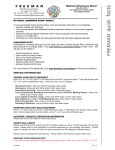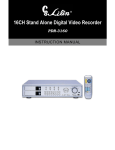Download Learn More
Transcript
FIRE SAFETY INFORMATION Fire Exit Drills in the Home Being ready is the key to surviving a home fire. There are three things YOU can do to protect your family. They are simple, but they are very important. Do them now, before fire strikes. 1. Install smoke alarms on every level of your home. 2. Test smoke alarms monthly to be sure they are working and replace batteries at least once a year. If your smoke alarm makes a "chirping sound" - replace the battery immediately. 3. Plan and practice home fire drills. Make a Home Escape Plan! Fire strikes quickly, often in the middle of the night while your family is asleep. Establish a plan now for evacuating each member of your family. Then, if fire does strike, everyone will know what to do and where to go. One of the ways to keep your family safe is by practicing E.D.I.T.H. (Exit Drills In The Home). Many injuries are caused by people of all ages reacting improperly when there is a fire in their home. They may be affected by smoke, disoriented by being awakened abruptly and frightened. It is critical that every household have a step-by-step plan for escaping a fire and practice it by having a "Home Fire Drill" at least twice a year. Remember, your primary route should be the quickest, most direct way out. For example, through the front door to your meeting place or through a window to a roof or balcony where you can safely wait for help. The secondary route should be the next safest, most direct path out. For example, through the window of the room next door. Unless your children are infants, don't have them wait for your help. In a fire, parents may be blocked from their children's bedrooms by smoke or flames. As soon as they are able, each child should know how to escape a fire and be taught to do so as soon as he or she smells smoke or hears the sound of the smoke alarm. Practice your plan with a HOME FIRE DRILL. Make sure everyone understands what to do and assess each escape route realistically to be sure it can be used in an emergency. Walk through the primary and alternative escape routes, ensuring that all exits are accessible to all members of your household. For example, will windows open easily? Are ropes and ladders required to escape from second-story windows? (If you choose to have escape ladders, always practice using a ground floor window). Practice your plan at night because things look very different in the dark. If windows or doors in your home have security bars, make sure that the bars have quickrelease mechanisms operational from the inside so that they can be opened immediately in an emergency. Quick-release mechanisms won't compromise your security, but they will increase your chances of safely escaping a home fire. Go outside to see if your house number is clearly visible from the street. Numbers must be visible to ensure that responding emergency personnel can find your home. In Montgomery County, Maryland existing residential home numbering can be 3 1/2 inches high, however new residential homes must be at least 5 inches high and if you replace existing numbers they must be at least 5 inches high. Numbers should be placed on a contrasting background, with a reflective coating on the numbers for easy visibility at night. Escape first and then call 9-1-1 from a neighbor's house. In the event of a fire, do not stop for anything. Do not try to rescue possessions or pets. Closing doors on your way out slows the spread of fire, giving you more time to safely escape. Go directly to your meeting place and then call the fire department from a neighbor's phone. Every member of your household should know how to call the fire department. Get out and stay out. Once you are out of your home, do not go back for any reason. If people are trapped, firefighters have the best chance of rescuing them. The heat and smoke of a fire are overpowering. Firefighters have the training, experience and protective equipment needed to enter burning buildings. Establish a meeting place outside your house and everyone should proceed to this location immediately to take attendance and make sure everyone has escaped. Crawl low under smoke. Smoke contains deadly gases and heat rises. During a fire, cleaner air will be near the floor. Teach your family that in a fire they must stay low to the floor to avoid smoke and intense heat. If you encounter smoke when using your primary exit, use your alternate escape plan. If you must exit through smoke, crawl on your hands and knees keeping your head 12 to 24 inches above the floor. Revise your escape plan as circumstances change in your household. Make sure everyone including young children, older adults and people with disabilities are included. Remember - children sleep very deeply. Adults need to make sure that children know the sound of the smoke alarm and what to do if they hear it. You can find out who can hear the smoke alarm if you have a fire drill when everyone else is sleeping. If anyone in your home does not wake to the smoke alarm or requires assistance getting out, plan to designate an adult to help them escape. General High-Rise Fire Safety Tips Before there is a fire: • • • • • Obtain a copy of your building's fire evacuation plan. Learn the parts of the evacuation plan that affect you. Plan and Practice TWO ways out of the building. Building management, staff, and residents should conduct at least one fire drill a year. Be sure that your smoke alarms have battery back-ups if they are electric powered (you will still be protected if the power is out). Learn how to test your smoke alarms, check them once a month and change your smoke alarms batteries at least twice each year. If there is a fire: • • Pull the fire alarm on your way out. Close the door(s) to the room containing the fire. Closing the door(s) will help to control the spread of smoke and fire. If your escape route has smoke, crawl low under the smoke. Stay close to the floor where the air is less toxic and the visibility is better. • • • • • • Count the number of doors between your door and the nearest stairway or exit (if there is a fire, you may have to find the stairwell while crawling down the hall in the dark). NEVER use an elevator in a fire (the elevator might lose power, or might unexpectedly open at the fire floor). Go directly outside (instead of to the parking garage). Once you are outside, go to your meeting place (not your car). Remember to call 9-1-1 from a safe location. Do not go back inside until the fire department has told you it is okay to do so (if you think someone is still trapped inside, stay outside so you don't become an additional victim, and so that you can tell the firefighters exactly where to search). If there is no safe way out or you are unable to physically leave the building: • • • • Put as many doors/rooms as you can between you and the fire. Seal all vents and cracks around doors with towels or clothing. Open a window slightly for fresh air, but not a lot because that will only feed the flames. Call the 9-1-1 dispatcher to explain exactly where you are. Let firefighters know you're trapped by waving a bright (white or yellow) cloth in the window or by using a flashlight at night. Fire Extinguishers Type A - Trash, Wood, Paper Type B - Flammable Liquids Type C - Electical Fires Information about fire extinguishers A fire extinguisher is your best defense against fires that have just begun to burn - IF you are properly trained and feel comfortable using them. Fire extinguishers can: • • give you enough time to escape from a burning structure. put out fires completely if used properly. Not using the correct type of extinguisher can make the fire spread. It is crucial to know the type of fire you are trying to put out before you attempt to use an extinguisher. If you have any doubt - GET OUT. Pull any fire alarms (if applicable) on the way out. Call 9-1-1 from a safe location! Proper locations for fire extinguishers Fire extinguishers should be located in rooms that the family gets the most use out of. They should always be in plain sight and easily accessible. Do not conceal them behind curtains, under tables, in a closet, or on the ground. At least one extinguisher should be kept on each floor of your household. They should also be kept in basements and garages. • • Extinguishers should be on walls no higher than five feet from the floor and near the exit and hazard areas Determine the hazard areas in your home, office, or other commonly used dwelling. Fire extinguisher guidelines Only attempt to extinguish fires when they are small - no larger than a small trash can! Time is valuable. Keep time on your side by knowing what's what and where to find it. Remember, fire can double in size approximately every sixty seconds. • • • • • Call the fire department, by dialing 911, from a safe location. Fire extinguishers should be maintained and ready for use at all times. Pressure gauges and carbon dioxide containers should be checked monthly. If your extinguisher does not have a pressure gauge be sure to get one that does All containers should be checked on a regular basis by all family members. Make it apart of everyday life. Proper training, conducted by trained professionals is the key to correct use of an extinguisher Keep detailed records. Always keep track of usage and service of your fire extinguisher. Records can also be helpful after a fire incident. Insurance companies may ask questions about extinguishers and their history. Keep your fire extinguisher serviced and maintained properly. Know the proper signs and symbols of fire extinguishers. Research the best kind of fire extinguisher(s) you might need for your home or office. Most fire extinguishers have universal symbols and/or pictograph systems. This helps classify which extinguisher fights a certain kind of fire. Different types of fires use different types of extinguishers Buying an extinguisher can be confusing. Each contains substances that extinguish different classes of fires. Some are multi-purpose extinguishers that can be used for more than one kind of fire: • • • Type A Fire Extinguisher- for fires that need a substance like water to cool burning materials down below ignition level. (Burning paper, cloth, wood, rubber, and plastics.) Type BC Extinguisher- contains chemicals that fight: (1) Class B fires (flammable liquids, gases and greases), and (2) Class C fires (energized electrical equipment, electrical fire and burning wires.) The BC extinguisher never contains water because water conducts electricity and spreads burning oils or solvents. Type ABC Extinguisher- multi-purpose extinguishers that fight all three types of fires. REMEMBER the basics of using extinguishers. Make sure you place yourself in a position to safely exit the area if you need to get out fast! Have the fire in front of you and your back to an exit so you can back out - DO NOT turn your back on a fire! Remember to NEVER go past a burning fire to retrieve an extinguisher. You may end up trapping yourself! Pull The safety pin at the top the extinguisher. Aim The nozzle, horn, or hose at the base of the flames. Squeeze Or press the handle. Sweep From side to side at the base of the fire until it goes out. Fireplace and Wood Burning Safety Fireplace and wood-stove ashes retain enough heat to ignite other combustible materials for several days after a fire. It is important to learn the following ways to dispose of fireplace and wood-stove ashes properly: • • • • • DO NOT discard your ashes into any combustible container like a paper or plastic bag, a cardboard box, or a plastic trash can. DO put ashes into a non-combustible metal container with a lid. DO pour water into the container to make sure the ashes are cool. DO keep your can OUTSIDE the home, away from combustibles. DO teach all family members to be safe with ashes from your fireplace or wood stove. As always, please make sure you test your smoke alarms monthly and replace batteries twice a year. Practice and plan a family home escape plan. Automatic Fire Sprinklers • • Council Bill #25-03 - Effective 1/14/2004 - Requires Fire Sprinkler Systems In New Single-Family Homes Council Bill #25-03 - Background - Requires Fire Sprinkler Systems In New Single-Family Homes The Facts • • • • • • • Automatic fire sprinklers have been in use in the U.S. since 1874. Fire sprinklers are widely recognized as the single most effective method for fighting the spread of fires in their early stages - before they can cause severe injury to people and damage to property. When one fire sprinkler head goes off to fight a fire the entire sprinkler system does NOT activate. Sprinklers react to temperatures in individual rooms. The chances of a fire sprinkler accidentally going off are extremely remote. Installation of fire sprinklers can provide discounts on insurance premiums. The costs for installing fire sprinkler systems in buildings 6 to 8 stories high ranges from under a dollar to about $2.00 per square foot in most new construction and from about $1.50 to $2.50 per square foot for retrofitting sprinklers in existing buildings. The installation of fire sprinklers in new residential construction is estimated to make up around 1% of the total building cost. (Similar to the cost of new carpet) • • • • Over 200 U.S. communities have residential sprinkler laws. Roughly 100 of these communities are in California. In downtown Fresno for example, there has been fire damage of only $42,000 during a 10-year period in which its sprinkler law has been in effect. According to the National Fire Protection Association, property damage in hotel fires was 78% less in structures with sprinklers than it was in structures without sprinklers during the years 1983-87. (Average loss per fire was $2,300 in sprinklered buildings and $10,300 in unsprinklered buildings.) Nearly half of all hotels and motels, according to a 1988 survey by NFPA, have sprinkler systems. NFPA has no record of a fire killing more than two people in a completely sprinklered building where the system was properly operating, except in an explosion or flash fire or where industrial fire brigade members or employees were killed during fire suppression operations. MYTHS AND FACTS ABOUT AUTOMATIC FIRE SPRINKLERS Automatic sprinkler systems have enjoyed an enviable record of protecting life and property for over 100 years. Yet, there are still common misunderstandings about the operation and effectiveness of automatic fire sprinkler systems: Myth 1: "Water damage from a sprinkler system will be more extensive than fire damage." Fact: Water damage from a home sprinkler system will be much less severe than the damage caused by water from fire-fighting hose lines or smoke and fire damage if the fire goes unabated. Quick response sprinklers release 8-24 gallons of water per minute compared to 50-125 gallons per minute released by a fire hose. Myth 2: "When a fire occurs, every sprinkler head goes off." Fact: Sprinkler heads are individually activated by fire. Residential fires are usually controlled with one sprinkler head. 90% of all fires are controlled with six or fewer heads and a study conducted in Australia and New Zealand covering 82 years of automatic sprinkler use found that 82% of the fires which occurred were controlled by two or fewer sprinklers. Myth 3: "A smoke detector provides enough protection." Fact: Smoke detectors save lives by providing a warning system but can do nothing to extinguish a growing fire or protect those physically unable to escape on their own, such as the elderly or small children. Too often, battery operated smoke detectors fail to function because the batteries are dead or have been removed. As the percent of homes in America that were "protected" with smoke detectors increased from zero to more than 70%, the number of fire deaths in homes did not significantly decrease. Myth 4: "Sprinklers are designed to protect property, but are not effective for life safety." Fact: Sprinklers provide a high level of life safety. Statistics demonstrate that there has never been any multiple loss of life in a fully sprinklered building. Property losses are 85% less in residences with fire sprinklers compared to those without sprinklers. The combination of automatic sprinklers and early warning systems in all buildings and residences could reduce overall injuries, loss of life and property damage by at least 50%. Cooking Safety Tips • • • • • • • • • • • Never leave cooking food on the stovetop unattended, and keep a close eye on food cooking inside the oven. Unattended cooking is the leading cause of home cooking fires. Three in every 10 reported home fires start in the kitchen - more than any other place in the home. Keep cooking areas clean and clear of combustibles (i.e. potholders, towels, rags, drapes and food packaging). Keep children and pets away from cooking areas by creating a three-foot (one-meter) "kid/pet-free zone" around the stove. Turn pot handles inward so they can't be bumped and children can't grab them. Clean cooking surfaces regularly to prevent grease buildup which can ignite. Wear short, close fitting or tightly rolled sleeves when cooking. Loose clothing can dangle onto stove burners and catch fire. Never use a wet oven mitt, as it presents a scald danger if the moisture in the mitt is heated. Always keep a potholder, oven mitt and lid handy. If a small grease fire starts in a pan, put on an oven mitt and smother the flames by carefully sliding the lid over the pan. You may also use baking soda. Turn off the burner. Don't remove the lid until it is completely cool. Never pour water on a grease fire and never discharge a fire extinguisher onto a pan fire, as it can spray or shoot burning grease around the kitchen, actually spreading the fire. If there is an oven fire, turn off the heat and keep the door closed to prevent flames from burning you and your clothing. Call 9-1-1 from a safe location. Never leave a child unattended in the kitchen. Close supervision is essential, whether children are helping an adult cook or simply watching. If there is a microwave fire, keep the door closed and unplug the microwave - If safe to do so. Call 9-1-1 from a safe location. Remember that food cooked in a microwave can be dangerously hot. Remove the lids or other coverings carefully to prevent steam burns. • Double-check the kitchen before you go to bed or leave the house. Make sure all other appliances are turned off. Outdoor Grilling Safety The onset of warm weather signals the beginning of Barbecue Season! Fire Chief Richard Bowers of the Montgomery County Fire & Rescue Service wants you and your loved ones to enjoy this season SAFELY! Below are some tips from the National Fire Protection Association that he hopes will help: • • • • • • • • • Always supervise a barbecue grill when in use. Position the grill well away from siding, deck railings and out from under eaves and overhanging branches. Keep children and pets far away from grills: declare a three-foot "safe zone" around the grill. With charcoal grills, only use charcoal starter fluids designed for barbecue grills and do not add fluid after coals have been lit. NEVER use gasoline! With gas grills, be sure that the hose connection is tight and check hoses carefully for leaks. Applying soapy water to the hoses will easily and safely reveal any leaks. All propane cylinders manufactured after April 2002 must have overfill protection devices (OPD). OPDs shut off the flow off propane before capacity is reached. OPDS are easily identified by their triangle-shaped hand wheel. Always follow the manufacturer's instructions and have the grill. repaired by a professional, if necessary. Remember to keep your grill clean! Periodically remove grease or fat buildup in trays below grill so it cannot be ignited by a hot grill. Wear short, close fitting or tightly rolled sleeves when cooking. Loose clothing can dangle onto grill and catch fire. • REMEMBER! Propane and charcoal BBQ grills must only be used outdoors. If used indoors, or in any enclosed spaces, such as tents, they pose both a fire hazard and the risk of exposing occupants to toxic gases and potential asphyxiation. Grilling Safety According to the Barbeque Industry Association, three out of four households in the United States own a barbeque grill. From making a quick dinner to barbequing a feast for family and friends, when lighting a charcoal or gas grill, it's important to remember that a savory barbeque is a safe barbeque. • According to the National Fire Protection Association (NFPA), gas and charcoal grills cause an annual average of 1,500 structure fires and 4,200 outdoor fires in or on residential properties, resulting in a combined direct property loss of $29.8 million. Make Fire Safety a Priority Protection can be relatively simple and inexpensive. To help prevent fire fatalities and injuries at your home this summer: • • • • • • • • • • Only use your barbeque grill outside. Grills are not designed to be used in a trailer, tent, garage, or house. Carbon monoxide can build-up and poison you. Set-up a grill in an open area away from buildings, overhead combustible surfaces, dry leaves or brush. Be sure to avoid high traffic areas and always barbeque in a wellventilated area. Be aware of wind blown sparks. Always read the owners manual before using the grill. Never use a grill indoors. Use the grill at least 10 feet away from your house or any building. Do not use the grill in a garage, breezeway, carport, porch, or under a surface that can catch fire. Keep a multipurpose fire extinguisher within easy reach. When purchasing a fire extinguisher, choose the largest size that can be handled comfortably. Wear clothing that does not have hanging sleeves or apron strings, and use flame retardant mitts when adjusting hot vents. Never leave a grill unattended once it is lit. Use long-handled utensils to avoid burns and splatters. Never attempt to move a hot grill. • If using a charcoal grill, gasoline should never be used in place of charcoal lighter fluid. And never reapply charcoal lighter fluid after the fire has started; the flames can ignite the vapors, and travel up to the can causing an explosion. Consumers should use caution when storing LP gas containers. Always keep containers upright. Never store a spare gas container under or near the grill or indoors. Never store or use flammable liquids, like gasoline, near the grill. To avoid accidents while transporting LP gas containers, consumers should transport the container in a secure, upright position. Never keep a filled container in a hot car or car trunk. Heat will cause the gas pressure to increase, which may open the relief valve and allow gas to escape. Consumers should use extreme caution and always follow manufacturer's instructions when connecting or disconnecting LP gas containers. Grills manufactured after October 1, 1995, are required to have three additional safety features to eliminate leak hazards: a device to limit the flow of gas in the event of hose rupture; a mechanism to shut-off the grill; and a feature to prevent the flow of gas if the connection between the tank and the grill is not leak proof. Consumers should consider purchasing grills that have these safety features. Sources: U.S. Consumer Product Safety Commission and NFPA Clothes Dryer Fire Safety Tips While most home appliances are used without incident, the U.S. Consumer Product Safety Commission estimates that 15,500 fires associated with clothes dryers occur annually, causing an average of 10 deaths, 310 injuries and more than $84.4 million in property damage. A lack of maintenance, buildup of lint, placing inappropriate items in the dryer and inadequate venting are frequently cited as contributing factors. Did You Know? • • • The U.S. Consumer Product Safety Commission (CPSC) estimates that 15,500 clothes dryer fires occur annually, causing an average of 10 deaths, 310 injuries and more than $84.4 million in property damage. Eighty-percent of American homes have clothes dryers. A full load of wet clothes placed in a dryer contains about one half gallon of water. As the clothes dry, lint forms and builds up, reducing airflow in the dryer's vent, potentially causing the dryer to work improperly or overheat. Clothes Dryer DOs: • • • • • • DO clean the lint screen/filter before or after drying EACH load of clothes. DO clean the dryer vent and exhaust duct periodically. DO have a certified service technician clean and inspect the dryer and venting system regularly. DO replace plastic or vinyl exhaust hoses with rigid or flexible metal venting, which provides maximum airflow. DO keep the area around the dryer clean and free from clutter. Always use the appropriate electrical outlet for dryers and all major appliances. Clothes Dryer DON'Ts: • • • • • • DON'T place clothing or fabric stained with a flammable substance, such as alcohol, cooking oils, gasoline, spot removers or motor oil, in the dryer. Flammable substances give off vapors that could ignite or explode. Instead, dry the materials outdoors. DON'T leave a dryer operating if you are not home. DON'T forget to read the manufacturer warnings in the user manual and on the inside of the dryer door DON'T dry any item containing foam, rubber or plastic, such as bathroom and non-slip rugs and athletic shoes. DON'T dry any item that contains glass fiber materials, such as a blouse or sweater with glass buttons or decorations. DON'T overload the dryer with wet clothes. Children and Smoke Alarms Statistics point to a fifty percent reduction in fire fatalities since the introduction of smoke alarms into the home. Although 90% of all residences have smoke alarms today, no smoke alarms were present in 42% of residential structure fires where fatalities occurred. Smoke alarms were present in 58% of fatal residential structure fires, but only operational in 37% of those fatal fires. That means that most often where smoke alarms are present in a fatal fire, the smoke alarm is nonfunctional due to dead or missing batteries. What is imperative at the moment is for our citizens to understand the need not to rely solely on smoke alarms as the entire answer to escaping from fire. These recent news events serve to reinforce the need for home escape planning. Smoke alarms are a tool in the planning process. Parents need to clearly understand their supporting roles in the escape plan. After going over the plan with your family, you should conduct a walkthrough of the plan. When you feel comfortable with your plan, hold a fire drill at night (activate your alarm) while your children are sleeping so that you and they can determine the appropriate response to a smoke alarm. Prevent Arson & Protect Your Property Important Numbers • • • • • • • • Fire/Police/Ambulance Emergency 9-1-1 Fire and Explosive Inv. Office 240-777-2255 Arson Tip Line 240-777-2263 Crime Solvers Tip Line 240-773-5038 Police Community Relations 301-840-2690 Non Emergency Police voice/tty 301-229-8000 Non-Emergency Fire Rescue Service 240-777-2400 Fire Safety in the Neighborhood 240-777-2476 Religious Worship Centers Arson is one of the leading causes of all commercial building fires. People associated with your place of worship can decrease the chances of arson by organizing and investing in a fire and crime prevention program. You and your organization can also take other measures to protect your facility from fire. Use this guide to learn more about risk reduction and fire prevention for your organization. Why are Churches and Religious Organizations Particularly Vulnerable to Arson? Most places of worship have predictable schedules. They also have multiple staff and volunteers in leadership positions that may often result in inconsistent security. Also, such facilities often become targets because of what they represent. How Can You Help Reduce the Risk of Arson and vandalism? • • • • • • Keep doors and windows locked when the building is unoccupied. Light all sides of the building and parking areas. Trim shrubbery to prevent it from being used for hiding. Remove loose material combustibles and trash from the property. Have police routinely check premises. Become involved in a "Neighborhood Watch" program. Religious Worship centers Community Awareness: The Montgomery County Fire and Rescue Service will work with each and every community in an effort to prevent/deter persons from burning religious places of worship in our community. • • • • • • Have your members of the congregation check your the building daily. Leaders of congregations should appoint appropriate members to familiarize themselves with the risk assessment guidelines and work with community. Report all suspicious persons, vehicles, or activities in or near your place of worship. The goal of this intiative is to involve the citizens that live in the immediate area of places of worship to unify and be trained on surveillance and observation methods that can be a deterrent to crime. Encourage neighbors and church members to take note of strangers spending time in the neighborhood, both on foot or in cars; to record tag numbers of suspicious vehicles; and to inform the proper authorities of suspicious activities. Alter activities at your church. Use it on different days and times. Schedule events and activities throughout the week. Ask everyone living near your place of worship to keep an eye on the building. Involve the community. When appropriate, check for proper identification from utility and service technicians seeking to gain access to the church facility. Remember vandalism and burglary may precede arson. Be vigilant. Internal Security • • • • • • • Use properly installed deadbolt locks on all doors. Windows that can be opened should have adequate locks. Consider decorative iron protection for windows. Windows that are used for emergency exits must be able to open in case of emergency. Solid wood or sheet metal faced doors provide extra security. Install adequate fire burglar alarm system, preferably with a phone dialer. Be sure to have a list of the individuas who have access to the building keys and change locks periodically. Consider video surveillence. External Security • • • • • • • • • • Install lighting on the exterior as well as the entrance of the building. Install perimeter floodlighting. Install motion-activated lighting near windows and doors. Keep trees and other shrubs trimmed so that passing patrols can easily see the building. If in a rural area, make sure that crops are far from the building to allow proper lighting. Do not have signs block the view of the building. Many religious buildings have basement entrances that are hidden. Secure these entrances by locking them when a gathering or worship is not in session. Ladders, stairways and other fire escapes that allow access to the roof should be secured. Use white paint or light colored brick to construct the building of worship so that human figure can easily be identified in the dark. Consider fencing the areas that are not easily visible to patrols and neighbors. Consider video surveillence. Checklist • • • • • • • • • • • • Install night lighting. Secure buildings with strong locks on windows and doors. Eliminate woodpiles, paper, and leaves that are around the church that could fuel a fire. Secure flammable liquids and other materials inside the church that could fuela fire. Limit the number of entrances into the building while still providing adequate emergency exits. Be alert to unusual activities in the neighborhood. Install a central station security and fire detection system. Keep valuables locked up and out of sight. Prevent unauthorized access to the roof, fire escapes, and stairwells. Assign personnel to secure the building. Limit keys to management only. Leave some interior lights on at night. Source: http://www6.montgomerycountymd.gov/content/frs-safe/resources/index.asp
















